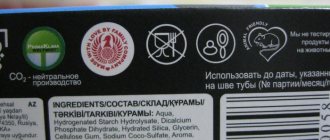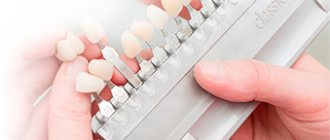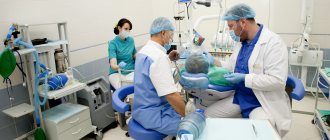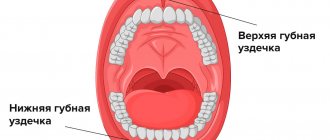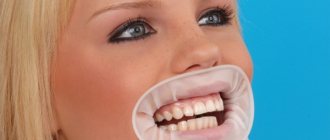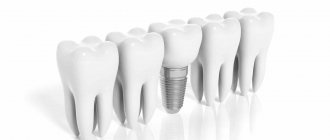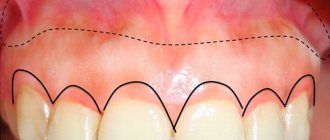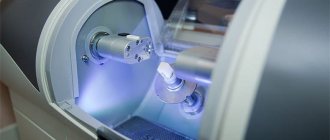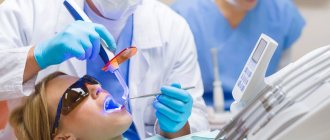Electrophoresis in dentistry is a physiotherapeutic procedure when medicinal substances are introduced into the body through electric current. This method uses special compounds that, under the influence of electricity, disintegrate into ions, accumulate in the pathological area and have a targeted effect on it. Thus, maximum therapeutic effect is achieved.
Indications for the use of electrophoresis in dentistry
- periodontitis;
- pulpitis;
- glossalgia;
- glossitis;
- purulent and inflammatory diseases of the oral cavity;
- dental cysts;
- dental granulomas;
- pathology of the facial nerve;
- inflammation of dental cells (alveolitis);
- lesions of the oral mucosa;
- severe pain after treatment or tooth extraction.
Despite the rapid development of technology in dentistry, electrophoresis has been and remains one of the most effective and affordable physiotherapeutic methods for treating hard and soft dental tissues.
Contraindications
When prescribing physiotherapy, special attention should be paid to contraindications. They can be general, that is, they are not suitable for any physical impact, and specific - for each procedure there is a separate additional list.
Physiotherapeutic procedures should not be prescribed in cases of detection of these diseases:
- Neoplasms or suspicion of their presence.
- Tendency to bleed.
- Atherosclerosis.
- Heart failure.
- Intoxication.
- Cachexia.
- Skin diseases.
- Systemic blood diseases.
- Individual intolerance.
Exposure to physical factors in the presence of general contraindications can lead to a sharp deterioration in health.
Features of electrophoresis for teeth
The procedure is performed in a treatment room and is comfortable and painless. Allows you to quickly relieve pain in the tissues, inside the dental canal, thereby eliminating foci of infection. Medicines are administered slowly, and the therapeutic effect lasts for several weeks. The risk of developing allergic reactions is minimal.
Medicines used in electrophoresis:
- lidocaine;
- iodine;
- vitamin cocktails;
- calcium;
- a nicotinic acid;
- novocaine, etc.
Purified water, dimexide, and buffer compounds are used as solvents.
Drug electrophoresis in dentistry is performed as follows:
- a special pad is wetted in the medicinal composition;
- the element is fixed at the site of inflammation;
- when treating pulpitis, the teeth are pre-treated and the drug is simultaneously injected into the canals;
- the tissues of the oral cavity are exposed to weak current pulses through the pad;
- The patient is given an electric current with a gradual increase in strength until painful sensations appear. Thus, the optimal indicator of the power of impact on the zone is determined;
- the procedure lasts about 10 – 30 minutes.
The average duration of an electrophoresis course is 10-20 procedures, which are performed daily or with breaks of one or two days.
Types of physiotherapy and mechanism of action
Under the influence of various physical factors, the physiological processes of the body are activated. With the rational use of physical therapy in dentistry, it is possible to control these processes and obtain the desired result.
Depending on the type of impact factor, there are different types of physiotherapy.
| Physical factor | Physiotherapy |
| Electric current (alternating, direct, high or low frequency, strength, voltage) | Depophoresis Galvanization and electrophoresis Amplipulsetherapy Fluctuarization Darsonvalization Ultratone therapy UHF therapy |
| Light | Laser therapy |
| Warm | Paraffin therapy Mud therapy |
| Ozone Air particles | Ozone therapy Aeroinotherapy |
| A magnetic field | Magnetotherapy |
| Oscillations (mechanical, electromagnetic) | Ultrasound therapy Microwave therapy |
| Pressure | Massage (hydromassage, vacuum, manual) |
Against the background of activation of the physiological processes of the body, the following effects are observed:
- Stimulation of the immunobiological system.
- Desensitization.
- Activation of the endocrine glands (pituitary gland, thyroid gland).
- Regulation of hematopoietic function.
- Improving collateral blood flow.
- Abundant supply of tissues with oxygen.
- Strengthening regenerative processes (fast wound healing).
- Activation of the anticoagulant system.
- Production of endorphins, which has an analgesic effect.
- Activation of proteolytic enzymes and leukocytes in the lesion, which leads to a bactericidal effect.
The method of physical influence should be carefully chosen, taking into account both the local and general reaction of the body. The result for each patient may be different depending on the general condition and clinical picture of the disease.
Treatment principle
Laser treatment is based on the principle of local exposure of the beam to a specific type of tissue. The beam does not affect neighboring areas. Targeted action allows you to remove carious and inflamed areas without affecting healthy enamel, gum tissue and dentin.
Carious tissues contain more moisture. Under the influence of the laser, moisture evaporates from them intensively - tissues affected by caries are gradually destroyed. In 3-5 therapy sessions, the doctor removes all diseased tissue without affecting healthy areas.
When treating periodontitis, it is necessary to remove infected areas that have changed their structure. To do this, the dentist treats the gums with a special solution that reacts with the affected cells. The solution stains the pathological areas, after which the laser acts on them. It evaporates and destroys them without damaging healthy areas.
Methodology
Thanks to compact and universal equipment, physiotherapy can be carried out in a dental clinic, provided it is equipped. It is also possible to carry out the procedure in a clinic or hospital upon referral from a doctor free of charge.
| Main action | Indications | How to do it | |
| Laser therapy | anti-inflammatory healing painkiller disinfectant bone-forming | caries, pulpitis, periodontitis gingivitis, periodontitis, stomatitis injuries, viral and bacterial diseases of the mucous membrane dental surgery | A helium-neon or conductive laser is used. The radiation is directed to tissue and penetrates to different depths. |
| Depophoresis | cleans and sterilizes root canals due to the copper depot, it creates a tightness of the main and periapical branches stimulates bone tissue regeneration | treatment of difficult canals tool breakage unsuccessful dental treatment wide apical foramen | Three visits are required. A suspension of copper and calcium hydroxide is injected into the prepared canal. Using the cathode and anode, the current is increased until heat and tingling appear. |
| Galvanization and Electrophoresis | absorbable action improvement of metabolic and reparative processes long-term effect of the drug passage of medicine through the narrow canals of the tooth | periodontitis trauma, broken bones periodontitis tooth sensitivity non-carious lesions implant installation | The effect of direct current and drugs occurs using the cathode and anode. |
| Amplipulse therapy (SMT therapy) | anesthesia improvement of metabolism activation of the neuromuscular system | stomalgia, neuritis, glossalgia, neuralgia salivary stone disease muscle stimulation | The electrodes are fixed. They supply alternating current, constantly changing in amplitude and frequency. A slight vibration is felt due to the contraction of muscle fibrils. |
| Fluctuarization | anti-inflammatory painkiller regenerating | periodontitis acute inflammation of the mucous membrane | Electrodes are installed on the skin, and a cathode is installed in the oral cavity. Low current and low voltage are supplied. |
| Darsonvalization | analgesia regulation of metabolic processes activation of regenerative processes | periodontitis gingivitis aphthous stomatitis abscess, phlegmon | Vacuum electrodes are used; they create a pulsed current of high frequency and high voltage, but of low strength. |
| Ultratone therapy | vasodilation improved blood circulation reduction of toothache desensitization resorption of adhesions and infiltrates | periodontitis periostitis wounds and ulcers in the mouth periodontitis neuritis arthritis | Electrodes filled with neon are applied. High frequency current with a power of up to 10 W is supplied. |
| Ozone therapy | strengthening local immunity stimulation of regeneration anesthesia antimicrobial effect | wounds, ulcers, abscess, phlegmon, candidiasis, herpes periodontitis periodontitis caries pulpitis sinusitis | An ozone-oxygen gas mixture is supplied to the mucous membrane or gum through a tube under pressure. It is possible to use ozone solutions in the form of irrigations, applications, rinses and injections. |
| Microwave therapy | vasodilator painkiller anti-inflammatory trophic | periodontitis gingivitis, stomatitis, alveolitis (chronic form) periodontitis | It is carried out with an emitter of various widths. Apply to the skin in the area of projection of the lesion and apply electromagnetic vibrations. |
| UHF therapy | antispasmodic regenerating increased salivation anti-inflammatory | injury to bones and soft tissues periostitis, osteomyelitis, abscess, phlegmon neuritis | Capacitor plates are applied and an ultra-high frequency electromagnetic field is formed. |
| Aeroinotherapy | acceleration of recovery processes activates adaptation mechanisms | stomatitis periodontitis wounds, ulcers on mucous membranes | The patient sits and inhales ionized air. |
| Massage (hydro, vacuum, manual) | improved blood circulation, stimulation of regeneration | neuritis contractures periodontitis periodontal disease | Using a special nozzle, water is supplied under pressure or, conversely, a vacuum is created. Finger massage with honey will be useful for every patient at home. |
| Ultrasound therapy | antispasmodic reparative painkiller anti-inflammatory absorbable activation of metabolic processes | periodontitis periodontal disease pulpitis, periodontitis diseases of the mucous membranes neuritis periostitis, osteomyelitis | The mucous membrane is coated with oil, then the emitter is passed, without coming off, along the transitional fold. The impact factor is ultra-high frequency mechanical vibrations. |
| Magnetotherapy | decongestant anti-inflammatory reparative | periodontitis trauma to the oral mucosa postoperative wounds bone fractures implant installation | It is carried out by an inductor that acts on a continuous magnetic field. |
| Diathermocoagulation | prevents bleeding reduces postoperative pain prevents the absorption of microbes and toxins through the vascular wall | pulpitis periodontitis periodontitis hemangiomas benign neoplasms | Electrodes in the form of a root needle, knife or ball are used. A current of high frequency, high strength and density is supplied. |
Physiotherapy of teeth and gums should be carried out systematically, at least 5-15 procedures per course of treatment, since the accumulation of the dose and its potentiation in the future works.
Therapeutic effect
The use of physiotherapy methods allows you to achieve the following effects:
- reduction of treatment time;
- acceleration of the recovery period;
- therapy has a healing, disinfecting, antibacterial effect;
- reduction of pain syndrome;
- healing, activation of tissue regeneration;
- achieving positive dynamics in stagnant, chronic processes.
The first results are visible after the first or second procedure. But treatment cannot be interrupted; the course should be completed unless there is an indication for interruption. Therefore, the doctor must monitor the therapy and the patient’s condition.
Treatment of caries
Caries is the destruction of hard tooth tissue due to chemical exposure and the activity of pathological microflora.
Another example from practice. 270 patients underwent laser treatment, and Moscow dentists diagnosed multiple caries in 150 of them. The treatment was carried out using a RIKTA laser therapy device using dental attachments. Doctors acted on the affected teeth for 1-2 minutes with a pulse frequency of 50 Hz.
In case of multiple caries, radiation was applied to the submandibular and parotid glands. This effect stimulates the production of immunoglobulin and reduces the viscosity of saliva. The duration of the procedures is 2 minutes, with a pulse of 50 Hz.
Each patient received a course of 8-10 laser therapy sessions. Over the next year, 86% of patients did not develop caries. For comparison, in patients undergoing traditional treatment, this figure was 61%.
Innovative painkillers
Dental restoration using general anesthesia is a thing of the past. Modern anesthesia is applied locally and does not cause side effects.
The most popular option is sedation. An anesthetic in which the patient is conscious but does not feel pain during surgery. New types of anesthesia also act as a sedative to reduce patient anxiety during the procedure.
Modern types of painkillers are effective for no more than 1.5-2 hours. After which the patient returns to his normal life, without problems with health.
